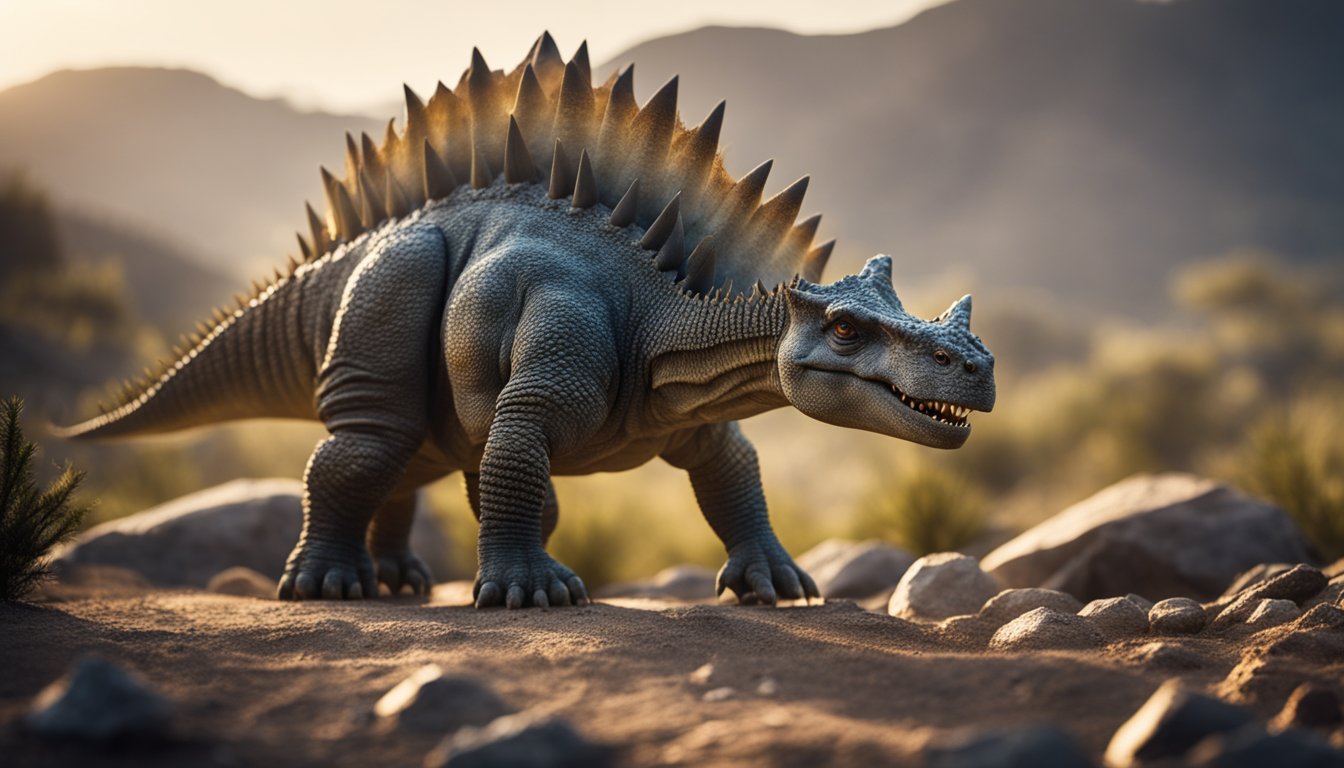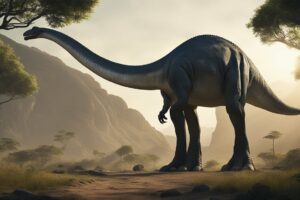Hesperosaurus, also known as the “Western Lizard,” was a plant-eating dinosaur that roamed the earth during the Late Jurassic period, approximately 154 to 142 million years ago.
This dinosaur was a member of the Stegosauria group, which includes some of the most iconic dinosaurs known for their distinctive plates and spikes.

What sets Hesperosaurus apart from other Stegosauria is the arrangement of its spikes.
While most stegosaurs had two rows of plates and spikes, Hesperosaurus had a single row of rounded plates running down its back and four bony spikes called thagomizers at the end of its tail.
These thagomizers were angled slightly backward, making them more effective as a defensive weapon against predators.
Despite the fact that Hesperosaurus was not as well-known as some of its more famous relatives, this dinosaur has been the subject of much scientific research.
In this article, we will explore the fascinating world of Hesperosaurus, examining what we know about this dinosaur, how it lived, and why it remains a source of fascination for paleontologists and dinosaur enthusiasts alike.
Discovering Hesperosaurus
Hesperosaurus, also known as the Western Lizard, is a herbivorous dinosaur that lived during the Late Jurassic period, approximately 156 million years ago.
It was discovered in the Morrison Formation of Wyoming, United States, in 1985 by Patrick McSherry.
Fossil Finds in Wyoming
Wyoming is known for its rich fossil finds, and Hesperosaurus is one of the many dinosaur species discovered in the state.
The Morrison Formation, where Hesperosaurus was found, is a geological formation that spans across several states in the western United States, including Wyoming.
The formation is known for its abundance of dinosaur fossils, including those of the famous Stegosaurus.
Naming the Western Lizard
Hesperosaurus was named by Carpenter, Miles, and Cloward in 2001.
The name Hesperosaurus comes from the Greek words “hesperos” meaning “western” and “sauros” meaning “lizard”.
The species name, “mjosi”, was named after the landowner who discovered the fossil.
Hesperosaurus mjosi is the type species of the genus Hesperosaurus.
The discovery of Hesperosaurus has provided important insights into the evolution and diversity of stegosaurs during the Late Jurassic period.
The fossils of Hesperosaurus have helped scientists better understand the anatomy and behavior of these fascinating creatures.
For example, the spikes on the tail of Hesperosaurus, known as “thagomizers”, were likely used for defense against predators.
Overall, the discovery of Hesperosaurus has contributed greatly to our understanding of the natural world and the history of life on Earth.
It serves as a reminder of the incredible diversity of life that has existed on our planet, and the importance of preserving and studying these fossils for future generations to learn from and enjoy.
Anatomy of a Spiky Back

Hesperosaurus, the Western Lizard, is a herbivorous dinosaur that lived during the Late Jurassic period.
It is known for its unique spiky back, which is made up of a series of bony plates and spikes that run down its spine.
Tail Tales and the Thagomizer
The tail of Hesperosaurus is also a notable feature, as it ends in a cluster of four bony spikes known as the thagomizer.
These spikes were likely used for defense against predators, as well as for combat with other Hesperosaurus individuals during mating season.
Bony Plates and Spikes
The bony plates on Hesperosaurus’ back were not only for protection, but also for thermoregulation.
The plates were covered in a layer of keratin, which acted as insulation to regulate the dinosaur’s body temperature.
The exact number of plates on Hesperosaurus’ back is unknown, but it is estimated to be around ten.
These plates were arranged in two rows, with the larger plates on top and the smaller plates on the bottom.
The spikes on Hesperosaurus’ back were also covered in a horn sheath, which added an extra layer of protection.
The spikes were likely used to deter predators, as well as for display during courtship rituals.
Hesperosaurus’ skeleton is also an impressive sight, with 13 back vertebrae, 3 sacrals, 44 tail vertebrae, neck ribs, dorsal ribs, chevrons, left shoulder blade, pelvis, and ossified tendons.
Fun fact: Hesperosaurus is often compared to the more well-known Stegosaurus, which also had a spiky back.
However, Hesperosaurus is smaller and has a different arrangement of plates and spikes on its back.
Hesperosaurus’ Habitat and Lifestyle

Diet and Dining Habits
Hesperosaurus was a herbivore, which means it only ate plants.
It lived during the Late Jurassic period, about 156 million years ago, in what is now the western United States.
Hesperosaurus was a member of the Stegosauria family, which included other plant-eaters like Stegosaurus and Kentrosaurus.
Hesperosaurus had a beak-like mouth that was perfect for snipping off pieces of plants.
It ate a variety of vegetation, including moss, cycads, conifers, and ferns.
Scientists believe that Hesperosaurus had a large gut to help it digest tough plant material.
Defending Against Predators
Hesperosaurus had a spiky back that was likely used for defense against predators.
It had two rows of bony plates that ran down its back, which were embedded in its skin.
These plates were not sharp, but they would have made it difficult for predators to bite Hesperosaurus without getting hurt.
Hesperosaurus also had a thagomizer on the end of its tail, which was a set of four spikes that pointed backwards.
These spikes were likely used to defend against predators like Allosaurus.
Scientists have found evidence of Allosaurus bite marks on Hesperosaurus bones, which suggests that Hesperosaurus was a common prey item for these predators.
Overall, Hesperosaurus was a fascinating dinosaur that lived during a time when the western United States was covered in lush forests and filled with a variety of plant-eaters and predators.
Its unique features, such as its spiky back and thagomizer, helped it survive in a dangerous world.
The Evolutionary Tale of Stegosaurs

Stegosaurs, a group of herbivorous dinosaurs, are known for their iconic rows of plates and spikes along their backs.
These dinosaurs belong to the larger group of thyreophoran dinosaurs, which also includes ankylosaurs.
Stegosaurs lived during the Jurassic and early Cretaceous periods, from about 160 to 90 million years ago.
Relatives in the Stegosauria Family
The Stegosauria family includes two subfamilies: Huayangosaurinae and Stegosaurinae.
Huayangosaurinae is a group of early stegosaurs that lived during the Middle Jurassic period in China.
Stegosaurinae is a group of stegosaurs that lived during the Late Jurassic and Early Cretaceous periods in North America, Europe, and Africa.
Some of the most well-known stegosaurs include Stegosaurus, Dacentrurus, and Wuerhosaurus.
Stegosaurus, which lived during the Late Jurassic period, is the most famous stegosaur and is known for its large size and distinctive plates and spikes.
Dacentrurus, which lived during the Late Jurassic period in Europe, had longer and more slender spikes than Stegosaurus.
Wuerhosaurus, which lived during the Early Cretaceous period in China, had shorter and wider plates than Stegosaurus.
Scientific Studies and Findings
Phylogenetic studies have helped scientists understand the evolutionary relationships between stegosaurs and other dinosaurs.
These studies have shown that stegosaurs are more closely related to ankylosaurs than to other thyreophoran dinosaurs like Scelidosaurus.
Scientists have also studied the autapomorphies, or unique traits, of stegosaurs to better understand their evolution.
For example, researchers have studied the differences between the plates and spikes of different stegosaurs, as well as the shape and size of their skulls and teeth.
Overall, the study of stegosaurs has provided insight into the evolution of dinosaurs and the diversity of life during the Mesozoic Era.
Fun fact: Did you know that the plates and spikes of stegosaurs may have been used for display or defense against predators?
Frequently Asked Questions

What are the distinctive features of Hesperosaurus?
Hesperosaurus was a large, plant-eating dinosaur that lived during the Jurassic period.
One of the most distinctive features of Hesperosaurus was the row of rounded plates running down its back.
These plates were used for protection against predators. Additionally, Hesperosaurus had four bony spikes, known as thagomizers, at the end of its tail.
These spikes were used as a defensive weapon against predators.
How did Hesperosaurus differ from Stegosaurus?
Hesperosaurus was a primitive stegosaurid dinosaur that differed from Stegosaurus in a few ways.
Firstly, Hesperosaurus had a single row of rounded plates running down its back, while Stegosaurus had two rows of plates.
Secondly, the spikes on the end of Hesperosaurus’ tail were angled slightly backwards, pointing away from the body, whereas Stegosaurus’ spikes were angled vertically upwards.
Lastly, Hesperosaurus was smaller than Stegosaurus, with an estimated length of 18 feet, compared to Stegosaurus’ 30 feet.
Could you tell me about the diet of Hesperosaurus?
Hesperosaurus was a herbivorous dinosaur, meaning it fed on plants. Specifically, it likely fed on low-growing plants, such as ferns and horsetails.
Hesperosaurus had a beak-like mouth that it used to nip off vegetation.
It had a large gut that could ferment plant matter, which helped it extract as much nutrition as possible from its food.
What era did Hesperosaurus live in, and where have their fossils been found?
Hesperosaurus lived during the Jurassic period, approximately 150 million years ago.
Fossils of Hesperosaurus have been found in North America, specifically in the Morrison Formation, which spans across several states, including Colorado, Utah, and Wyoming.
How does Hesperosaurus compare to other dinosaurs with back plates?
Hesperosaurus is often compared to Stegosaurus, another well-known dinosaur with back plates.
While they share some similarities, such as the use of back plates for protection, there are also notable differences between the two.
For example, Stegosaurus had two rows of plates, while Hesperosaurus only had one.
Additionally, the spikes on the end of Hesperosaurus’ tail were angled slightly backwards, while Stegosaurus’ spikes were angled vertically upwards.
What was the function of the spikes on Hesperosaurus?
The spikes on the end of Hesperosaurus’ tail, known as thagomizers, were likely used as a defensive weapon against predators.
These spikes could inflict serious damage on predators, making Hesperosaurus a formidable opponent.
Additionally, the spikes may have been used in intraspecific combat, or combat between members of the same species, during mating season.






